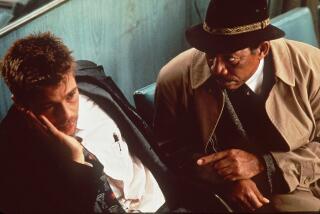A Second Look: Jim Jarmusch’s ‘Dead Man’
It’s often said that the journey is the oldest of narrative forms, and much of Jim Jarmusch’s career has been devoted to finding new variations on this ancient theme. His filmography abounds with road trips and wanderlust-stricken heroes, from the hepcat drifter in his no-budget debut, “Permanent Vacation,” to the enigmatic hit man on a mission through Spain in his latest, “The Limits of Control.”
But no Jarmusch journey has been as cosmic — as much of a trip, in every sense of the word — as his hallucinatory frontier odyssey “Dead Man.”
The film earned mixed reviews when it opened in 1996, nearly a year after its premiere at the Cannes Film Festival and after a reported wrangle over the final edit between Jarmusch and the distributor, Miramax. (The director always has insisted on final cut.) But its reputation has grown steadily in the years since. It ended up on many critics’ lists of the best movies of the ‘90s and some now consider it Jarmusch’s greatest achievement.
It makes its Blu-ray DVD debut this week through Echo Bridge, a company that signed on this year to distribute a chunk of the Miramax catalog.
Shot in richly modulated black-and-white by the cinematographer Robby Muller and featuring an improvised, feedback-heavy score by Neil Young, “Dead Man” is essentially one long death scene. A Cleveland accountant named William Blake (Johnny Depp) arrives at a town called Machine, an industrial hellhole at the end of the line, where he learns from a crazed factory owner (Robert Mitchum) that the job he had been promised no longer exists.
An encounter with a local girl that night leads to a shootout — the first of the film’s many awkward and absurd spasms of violence — and Blake escapes into the wilderness, bounty hunters on his trail and a bullet in his chest.
The rest of the film is a journey toward death that Jarmusch juxtaposes with the violent birth pangs of a destructive society and the spiritual regeneration of a lost soul. The timid Blake, transformed into an outlaw and a killer, finds a traveling companion in a Native American outcast named Nobody (Gary Farmer), who believes him to be the visionary English poet (Blake himself has never heard of his namesake) and prepares him to pass through “the mirror of waters” and into the spirit world.
Jarmusch has long made a specialty of seeing the United States through the eyes of outsiders: immigrants and tourists whose perspectives grant a new window onto America. It’s central to the politics of “Dead Man” that the designated role of the foreigner is filled by a Native American, a sardonic comment on the fate of the land’s original people in both history and movie mythology.
Unlike his film predecessors — typically reduced to the savage Other in the traditional western or recast as a fount of New Age wisdom in the more sensitive updates — Nobody is a complex and fully drawn figure, one of Jarmusch’s charismatic eccentrics but also a mouthpiece for the film’s eloquent fury.
But “Dead Man” is not a didactic tract. The William Blake reference — as well as the one to the French poet Henri Michaux, who provides the opening epigraph (“It’s preferable not to travel with a dead man”) — are hardly gratuitous name drops.
With its numerous internal rhymes and its hypnotic, incantatory rhythms, it’s a film that owes much to poetry in structure and syntax. Nobody quotes Blake frequently — lines like “The eagle never lost so much time as when he submitted to learn of the crow” could just as well be Indian sayings — and the film’s doomsday visions and anti-industrial, anti-capitalist bent align with Blake’s world view.
Countless pundits and scholars have seized on the western as the Hollywood genre most conducive to subtext and commentary, and this has proved true from Sam Peckinpah’s Vietnam-era films to Kelly Reichardt’s recent “Meek’s Cutoff,” which connects the doctrine of manifest destiny to foreign policy under George W. Bush.
“Dead Man” goes farther than just about any other neo-western in rethinking the rules of the game, from the depiction of violence to the portrayal of whites and Indians and even to the use of landscape, typically vast spaces of possibility but here filled with foreboding.
In Jarmusch’s hauntingly beautiful yet stubbornly unromantic film the genre devoted to the celebration of westward expansion is turned inside out. The nominal subject of most westerns is the opening up of the West, but everyone in this movie finds the world closing in around them.
More to Read
The biggest entertainment stories
Get our big stories about Hollywood, film, television, music, arts, culture and more right in your inbox as soon as they publish.
You may occasionally receive promotional content from the Los Angeles Times.










